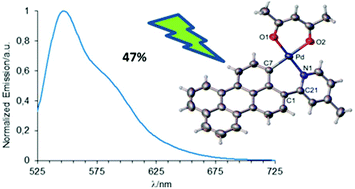Fluorescent perylenylpyridine complexes: an experimental and theoretical study†
Abstract
The perylene derivative 2-(3-perylenyl)-4-methylpyridine (HPerPy) was prepared and used to synthesize [Ag(HPerPy)(PPh3)(OClO3)], with the perylene ligand bonded to the metal centre only by the pyridine nitrogen. The treatment of HPerPy with [Pd(OAc)2] in methanol or acetic acid led to acetate bridged dimers (μ-OOCCH3)2[Pd(PerPy)]2, six-membered or five-membered cycled at the perylenyl fragment. Substitution reactions afforded mononuclear compounds [Pd(PerPy)(acac)] (six-member or five-member cycled) and [Pd(PerPy)(S2COMe)] (six-member or five-member cycled). The reaction of HPerPy with a platinum(II) fragment led to a five-membered cyclometallated Pt(II) complex [Pt(PerPy)(acac)]. The oxidative addition with MeI gave the corresponding cyclometallated Pt(IV) compound [Pt(PerPy)(acac)MeI]. X-ray single crystal studies of compounds [Ag(HPerPy)(PPh3)(OClO3)], (μ-OOCCH3)2[Pd(PerPy)]2-five-membered, [Pd(PerPy)(acac)]-six-membered, [Pd(PerPy)(S2COMe)]-five-membered, [Pt(PerPy)(acac)]-five-membered, and [Pt(PerPy)(acac)MeI]-five-membered confirmed the proposed structures. The UV-Vis spectra show one intense absorption with vibronic coupling in the visible region with maxima in the range of 448–519 nm. DFT calculations were carried out for the absorption spectra of the HPerPy molecule and representative complexes [M(PerPy)(acac)] (M: Pd, Pt; five and six-membered isomers) and [Pt(PerPy)(acac)MeI], showing that the lowest energy most intense transition in the complexes corresponds to the HOMO → LUMO transition in the perylene moiety, although affected by the metallacycle size and the metal nature. All the compounds are fluorescent in solution, due to the perylene fragment. The emission spectra display maxima in the range of 468–549 nm, with quantum yields from 1.1 to 82%. The attenuation of the intensity of fluorescence by the presence of heavy atoms and the formation of metallacycles has been experimentally determined and sequenced.



 Please wait while we load your content...
Please wait while we load your content...